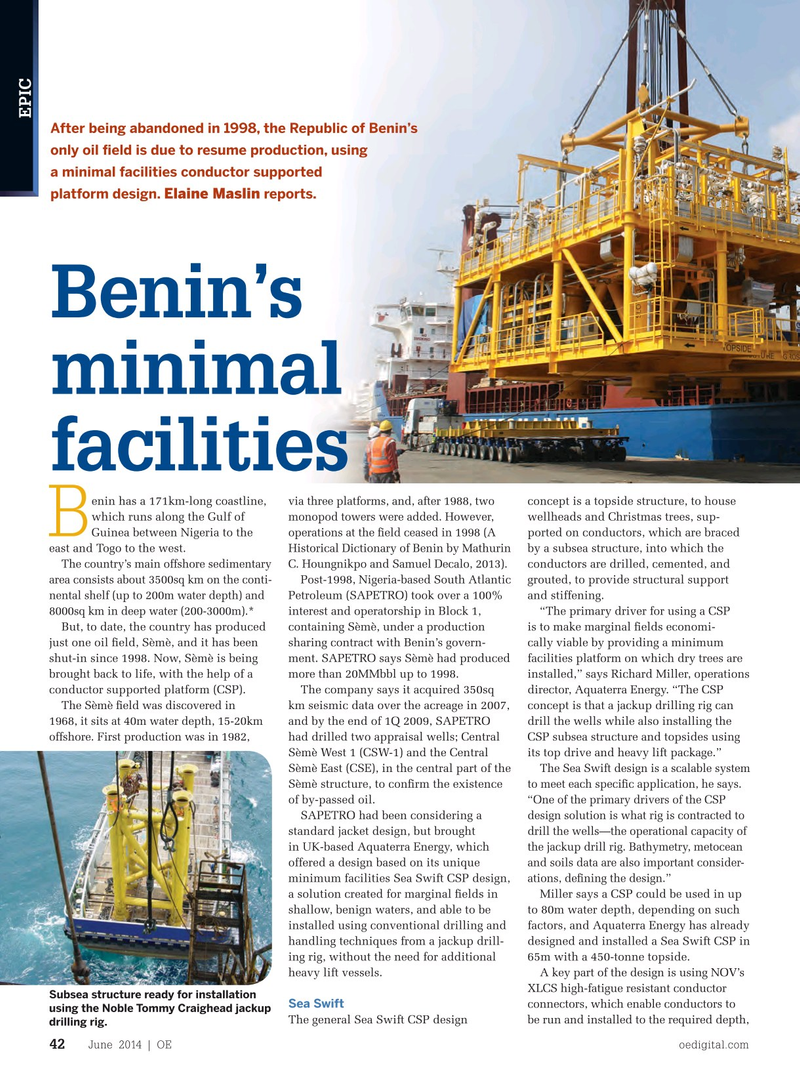
Page 40: of Offshore Engineer Magazine (Jun/Jul 2014)
Read this page in Pdf, Flash or Html5 edition of Jun/Jul 2014 Offshore Engineer Magazine
EPIC
After being abandoned in 1998, the Republic of Benin’s only oil ? eld is due to resume production, using a minimal facilities conductor supported platform design. reports.Elaine Maslin
Benin’s minimal facilities enin has a 171km-long coastline, concept is a topside structure, to house via three platforms, and, after 1988, two which runs along the Gulf of wellheads and Christmas trees, sup- monopod towers were added. However,
B
Guinea between Nigeria to the ported on conductors, which are braced operations at the ? eld ceased in 1998 (A east and Togo to the west. by a subsea structure, into which the
Historical Dictionary of Benin by Mathurin
The country’s main offshore sedimentary conductors are drilled, cemented, and
C. Houngnikpo and Samuel Decalo, 2013).
Post-1998, Nigeria-based South Atlantic grouted, to provide structural support area consists about 3500sq km on the conti-
Petroleum (SAPETRO) took over a 100% and stiffening.
nental shelf (up to 200m water depth) and interest and operatorship in Block 1, “The primary driver for using a CSP 8000sq km in deep water (200-3000m).*
But, to date, the country has produced containing Sèmè, under a production is to make marginal ? elds economi- just one oil ? eld, Sèmè, and it has been sharing contract with Benin’s govern- cally viable by providing a minimum shut-in since 1998. Now, Sèmè is being ment. SAPETRO says Sèmè had produced facilities platform on which dry trees are brought back to life, with the help of a more than 20MMbbl up to 1998. installed,” says Richard Miller, operations conductor supported platform (CSP). The company says it acquired 350sq director, Aquaterra Energy. “The CSP
The Sèmè ? eld was discovered in km seismic data over the acreage in 2007, concept is that a jackup drilling rig can 1968, it sits at 40m water depth, 15-20km and by the end of 1Q 2009, SAPETRO drill the wells while also installing the offshore. First production was in 1982, had drilled two appraisal wells; Central CSP subsea structure and topsides using
Sèmè West 1 (CSW-1) and the Central its top drive and heavy lift package.”
The Sea Swift design is a scalable system
Sèmè East (CSE), in the central part of the to meet each speci? c application, he says.
Sèmè structure, to con? rm the existence “One of the primary drivers of the CSP of by-passed oil. design solution is what rig is contracted to
SAPETRO had been considering a drill the wells—the operational capacity of standard jacket design, but brought the jackup drill rig. Bathymetry, metocean in UK-based Aquaterra Energy, which and soils data are also important consider- offered a design based on its unique ations, de? ning the design.” minimum facilities Sea Swift CSP design, a solution created for marginal ? elds in Miller says a CSP could be used in up shallow, benign waters, and able to be to 80m water depth, depending on such installed using conventional drilling and factors, and Aquaterra Energy has already handling techniques from a jackup drill- designed and installed a Sea Swift CSP in ing rig, without the need for additional 65m with a 450-tonne topside.
heavy lift vessels. A key part of the design is using NOV’s
XLCS high-fatigue resistant conductor
Subsea structure ready for installation
Sea Swift connectors, which enable conductors to using the Noble Tommy Craighead jackup
The general Sea Swift CSP design be run and installed to the required depth, drilling rig.
June 2014 | OE oedigital.com 42 042_OE0614_EPIC_Aquaterra.indd 42 5/22/14 9:57 PM

 39
39

 41
41